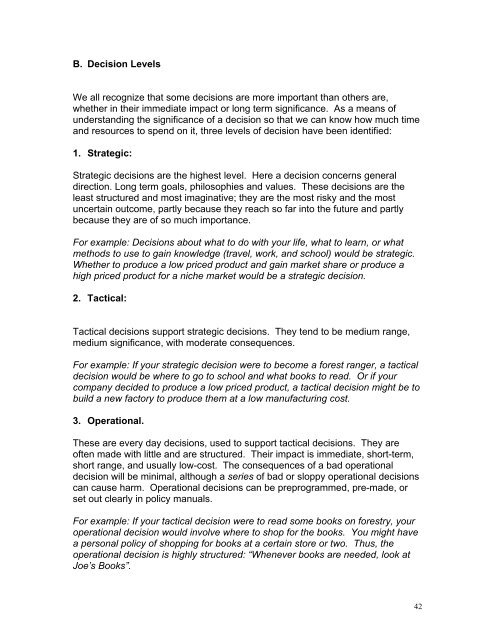Goal Setting, Planning and Decision Making
Goal Setting, Planning and Decision Making
Goal Setting, Planning and Decision Making
Create successful ePaper yourself
Turn your PDF publications into a flip-book with our unique Google optimized e-Paper software.
B. <strong>Decision</strong> Levels<br />
We all recognize that some decisions are more important than others are,<br />
whether in their immediate impact or long term significance. As a means of<br />
underst<strong>and</strong>ing the significance of a decision so that we can know how much time<br />
<strong>and</strong> resources to spend on it, three levels of decision have been identified:<br />
1. Strategic:<br />
Strategic decisions are the highest level. Here a decision concerns general<br />
direction. Long term goals, philosophies <strong>and</strong> values. These decisions are the<br />
least structured <strong>and</strong> most imaginative; they are the most risky <strong>and</strong> the most<br />
uncertain outcome, partly because they reach so far into the future <strong>and</strong> partly<br />
because they are of so much importance.<br />
For example: <strong>Decision</strong>s about what to do with your life, what to learn, or what<br />
methods to use to gain knowledge (travel, work, <strong>and</strong> school) would be strategic.<br />
Whether to produce a low priced product <strong>and</strong> gain market share or produce a<br />
high priced product for a niche market would be a strategic decision.<br />
2. Tactical:<br />
Tactical decisions support strategic decisions. They tend to be medium range,<br />
medium significance, with moderate consequences.<br />
For example: If your strategic decision were to become a forest ranger, a tactical<br />
decision would be where to go to school <strong>and</strong> what books to read. Or if your<br />
company decided to produce a low priced product, a tactical decision might be to<br />
build a new factory to produce them at a low manufacturing cost.<br />
3. Operational.<br />
These are every day decisions, used to support tactical decisions. They are<br />
often made with little <strong>and</strong> are structured. Their impact is immediate, short-term,<br />
short range, <strong>and</strong> usually low-cost. The consequences of a bad operational<br />
decision will be minimal, although a series of bad or sloppy operational decisions<br />
can cause harm. Operational decisions can be preprogrammed, pre-made, or<br />
set out clearly in policy manuals.<br />
For example: If your tactical decision were to read some books on forestry, your<br />
operational decision would involve where to shop for the books. You might have<br />
a personal policy of shopping for books at a certain store or two. Thus, the<br />
operational decision is highly structured: “Whenever books are needed, look at<br />
Joe’s Books”.<br />
42
















